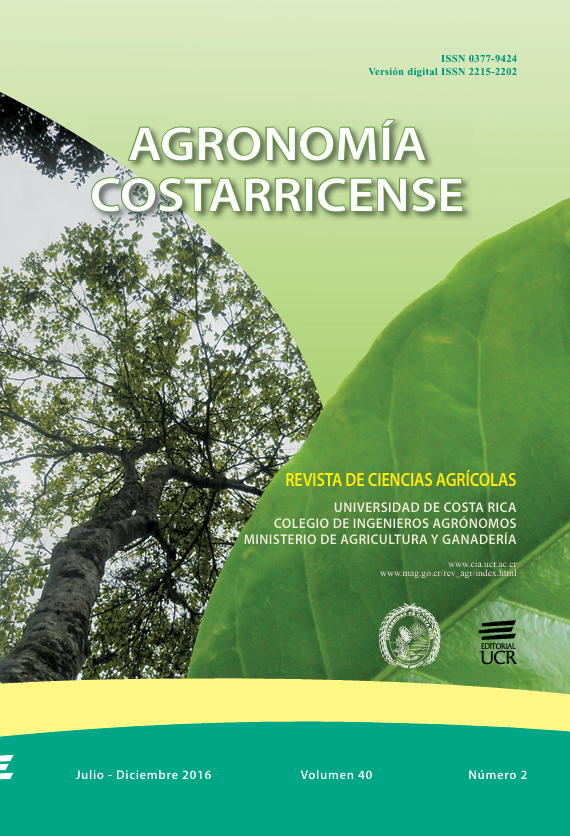Abstract
Field assessment of risks of microbiologic pollution in horticultural systems at the Central Valley of Costa Rica. During 2012 and 2013, a study was conducted involving 164 vegetable production systems, located in all farming areas of the Central Valley of Costa Rica. It aimed to establish the degree of compliance by producers, of critical points related to the risk of microbiological contamination. A list was made of 38 critical events located along the entire production chain, with which a survey tool was designed and passed on to producers of tomato, sweet peper, lettuce, celery and coriander. A frequency analysis was made with the results, which showed that most of the producers of tomato and sweet pepper use organic fertilizers that include animal wastes. In addition, there is a serious deficiency in sanitation, being a greater problem in the countryside than in the baler; the lock of hand-washing sinks is worst than of toilets. Most respondents have loose domestic pets in the production area. About 30% of companies only have river or creek water for the basic needs of field workers. Most of these companies, regardless of crop, use rivers and creeks as their main source of water for irrigation. Only a small percentage of the assessed companies have a well or store water. Almost all respondent’s farms are located in areas with high levels of human population, widespread presence of dwelling houses and of land used for livestock production. Serious problems in the cleaning of plastic containers used in harvest were detected. The study confirms the existence of a large number of unsuitable conditions in the management of vegetable crops, which increase the risk of contamination of the horticultural product.References
Andino, F; Castillo, J. 2010. Microbiología de los alimentos: un enfoque práctico para la inocuidad alimentaria. Universidad Nacional de Ingeniería. Estelí, Nicaragua. 61 p.
Astorga, Y. 2010. Diagnóstico de la microcuenca del río Purires. (en línea). PROGRAI, Universidad de Costa Rica. San José, Costa Rica. Consultado 16 jul. 2015. Disponible en http://www.ekeau.org/compurires/ DiagnosticoPurires.pdf
Barrantes, K; Achí, R. 2011. Calidad microbiológica y análisis de patógenos (Shigella y Salmonella) en lechuga. Rev. Soc. Ven. Microbiol. 31(1):31-36.
Barrantes, K; Chacón, LM; Solano, M; Achí, R. 2013. Contaminación fecal del agua superficial de la microcuenca del río Purires, Costa Rica, 2010-2011. Rev. Soc. Ven. Microbiol. 33(1):40-45.
Bernstein, N. 2011. Review potential for contamination of crops by microbial human pathogens introduced into the soil by irrigation with treated effluent. (Special Issue: Utilization of effluents for modern irrigation). Israel Journal of Plant Sciences 59(2/4):115-123.
Chin, JS; Ruíz, K; Aguilar, P; Arias, V; Masís, M. 2012. Caracterización de la calidad del agua de la Quebrada Sanatorio en Tierra Blanca ubicada en una zona agrícola de la provincia de Cartago y sus implicaciones para la salud pública. O Mundo da Saúde, São Paulo, Brasil 36(4):548-555.
FAO (Organización de las Naciones Unidas para la Agricultura, Italia). 2006. Informe. Utilización de los resultados de la evaluación de riesgos microbiológicos para elaborar estrategias prácticas de gestión de riesgos: parámetros para mejorar la inocuidad de los alimentos. Reunión de expertos. Kiel, Alemania. p. 4.
Habteselassie, MY; Bischoff, M; Applegate, B; Reuhs, B; Turco, RF. 2010. Understanding the role of agricultural practices in the potential colonization and contamination by Escherichia coli in the rhizospheres of fresh produce. Journal of Food Protection 11:1962-2140.
Hernández-Brenes, C. 2002. Mejorando la Seguridad y Calidad de Frutas y Hortalizas Frescas: Manual de Formación para Instructores. Sección II. Buenas Prácticas Agrícolas. Joint Institute for food safety and applied nutrition (JIFSAN). University of Maryland. Prince George, USA. 75 p.
Luna, J; Signorini, M; Díaz, R; Ordoñez, L. 2009. Evaluación de riesgos en alimentos. International Life Sciences Institute (ILSI), impreso por Black Light Group. México. 45 p.
Murray, P; Drew, W; Kobayashi, G; Thompson, J. 1995. Medical Microbiology. Mosby-Doyma Libros, S.A. Madrid, España. p. 423.
Odu, N; Okomuda, MO. 2013. Prevalence of Salmonella species and Escherichia coli in fresh Cabbage and Lettuce sold in Port Harcourt Metropolis, Nigeria, Report and Opinion 5(3):1-8.
Piñeiro, M; Díaz, LB. 2007. Aplicación de programas para el mejoramiento de la calidad e inocuidad en la cadena de suministro de frutas y hortalizas: beneficios y desventajas. Estudios de Casos de América Latina. Servicio de Calidad de los Alimentos y Normas Alimentarias. Organización de las Naciones Unidas para la Agricultura y la Alimentación, Roma, Italia. p. 6.
Vargas-Hernández, G; Durán-Quirós, A; González-Lutz, MI; Mora-Acedo, D. 2015. Perfil de riesgos de contaminación microbiológica y química en la cadena de producción de nueve productos hortícolas para consumo fresco, de un grupo de empresas agrícolas del Valle Central de Costa Rica. Revista Agronomía Costarricense 39(2):105-119.


